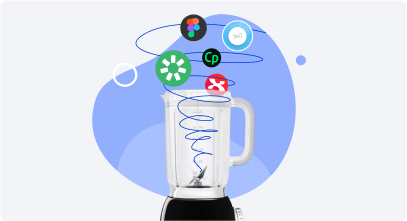Top 9 Free eLearning Authoring Tools

Are you looking for a free authoring tool that will let you create high-quality eLearning courses? You’ve probably almost given up on finding a decent solution with no hidden costs or time limits. But here’s some good news! We’ve done some deep research and tested nine courseware that cost nothing. Watch the video or read on to learn which free eLearning authoring tools are available and their strengths and weaknesses.
What Is an eLearning Authoring Tool?
An eLearning authoring tool is a software that enables you to create digital educational content, other known as eLearning output, to share with learners via a learning management system or on the Web. This learning content can be used in business and non-business spheres for employee training, onboarding, sales training, etc.
With authoring tools, you can create various training materials, including e-courses, video lectures, quizzes, simulations, etc., and save them in the eLearning formats. Some tools are focused only on building one type of training content, such as video tutorials or assessments. In contrast, others comprise a set of tools under one roof that cover a lot of tasks instructional designers or educators might need to deal with.
But when speaking about free solutions, it should be noted that their functionality is quite limited compared to paid eLearning software, but let’s look at what they offer.
Here’s a list of the best free eLearning authoring tools:
1. Free eLearning authoring tool #1 – iSpring Free

iSpring Free is a user-friendly authoring tool that lets you create slide-based courses with quizzes. With the tool, you can turn your ready-made presentations into interactive online courses – unlike other SCORM authoring tools, iSpring Free enables you to do this for no charge. It maintains all PPT animations, triggers, and transitions intact when converting.
Since the interface is familiar and intuitive, it’s also easy to build courses from scratch: just populate slides with texts, images, YouTube videos, and web objects – a page from Wikipedia or your corporate website, for example. There are three types of quiz questions for assessing learners’ knowledge: multiple-choice, multiple-response, and short answer. You can set feedback, the number of attempts, and time limits to enhance your quizzes.
The content created with iSpring Free automatically adapts to all devices and looks great on any screen, including PCs, Macs, tablets, and smartphones.
Pros
- Easy to use, no coding skills or training required
- SCORM compliant
- Allows you to convert PPT slides to HTML5/SCORM
- All PPT effects are kept intact
- Courses and quizzes look good and play well on any device
Cons
- Doesn’t work without PowerPoint installed
- Only three quiz question types are available
- The number of course slides is limited to 15
2. Free eLearning authoring tool #2 – Udutu

Udutu a free web-based tool for building courses. It comes with various WYSIWYG (‘what you see is what you get’) apps that let you create different activities, including assessments, interactive modules, and branching scenarios. Like iSpring Free, it enables you to convert your PowerPoint slides to online courses, but this option requires a subscription of $10 per month. You can download courses on your computer as SCORM packages. The tool also lets you upload previously authored SCORMs and reedit them.
Unlike many other authoring tools, Udutu makes it easy for multiple authors to collaborate on a course and review it in real time. However, the free membership allows you to distribute a link to a course only with watermarks placed on each slide.
Pros
- No programming skills required
- SCORM compliant
- Pre-designed templates
- Ability to create interactive learning objects and branching scenarios
- Quite a large variety of assessment questions
- Allows for uploading previously authored SCORM courses and re-editing them
Cons
- Not very steep, but it definitely has a learning curve
- PPT to SCORM/HTML5 conversion is available only for paid subscribers
- Previewing a course with no watermarks requires an advanced membership
- Frequent saves after testing are necessary; it is reported that saves are not automatic
3. Free eLearning authoring tool #3 – IsEazy

isEazy is another cloud-based authoring tool. It has a user-friendly interface, so almost no time is needed for mastering the tool. The free pricing plan and the paid plans allow you to build slide-based courses by using ready-made templates and designs that you can populate with texts, images, videos, and audio. The tool also enables you to add and customize interactive elements – you can create interactive quizzes, timelines, catalogs, process interactions, etc.
But despite quite a rich feature set and ease of use, the isEazy free version has significant limitations. The tool restricts its use to 3 eLearning projects and puts a 0.3 GB limit on the space for courses. You need to upgrade to a paid plan to remove these limitations and access more advanced authoring options.
Pros
- Easy to use, no tech skills required
- SCORM compliant
- A variety of good-looking templates
- Six quiz question types are available
- Provides an option to add interactive elements
- Provides a stock image bank, although it is limited to 500 image uses
Cons
- In the free version, courses are published with an isEazy logo and watermark
- A free plan is available for 1 author and 3 projects
- Puts a 0.3 GB limit on space
- Sequential navigation is available only in paid plans
- Cannot choose fonts
4. Free eLearning authoring tool #4 – Adapt

Adapt is one of the open-source tools for eLearning designed for rapid course authoring. It stands distinctly apart from other content developing tools that have evolved from a ‘PowerPoint’ format design. Courses built with Adapt provide a webpage-like experience – they scroll vertically, not flipped like slides. The authoring tool doesn’t support branching scenarios. It offers a minimal animation scope, so it is suited only to those who want to create long read courses with ‘linear navigation.’
Overall, the core functionality is sufficient to make simple online courses. Still, you can enhance the learner experience by installing additional Adapt plug-ins that will allow you to customize your content’s design. However, you need to have a techie mind to make some plug-ins work. Besides, it’s pretty challenging for a non-technical person to install Adapt. It requires the user to manually install and set up tools including Git, Node.js, and MongoDB and take steps that are usually hidden within a packaged installer.
Pros
- No coding skills required
- SCORM compliant
- Builds courses that are responsive across devices
- Hierarchy of development: Section>Page>Article>Block>Component
- Adapt plug-ins allow for a significant amount of custom design
- Supports languages that flow from right to left
Cons
- Sophisticated software installation and configuration
- Doesn’t run without Git, Node.js, Grunt, and MongoDB
- Customization aspects require technical know-how
- Limited variety of animations are supported
- Doesn’t support branching scenarios
5. Free eLearning authoring tool #5 – CourseLab

CourseLab version 2.4 is another free authoring software for building interactive eLearning courses that can be published on the web or to an LMS. Like many other tools, it allows you to create content in the WYSIWYG model. However, the interface looks a bit outdated and is not very intuitive, so CourseLab can seem quite complicated to use for non-technical users and developers.
This tool can be a good solution for tech geeks since it provides quite an extensive feature set. You can make slide-based courses with images, videos, complex multi-object interactions, and quizzes. CourseLab comes with an extensive collection of ready-to-use eLearning module templates, though learning how to use and customize them may require time.
Pros
- HTML or other programming skills are not necessary
- SCORM and AICC compliant
- Six quiz question types are available
- Built-in screen capture feature
- Embedded mechanisms for animating objects
- Tree-like course structure
- Access to additional functionality of the Course Player for advanced users via JavaScript
Cons
- The clunky, unintuitive user interface requires some training
- Outdated design
- Java script, Shockwave, and Real Player are required for some media files
- Reported that the content doesn’t run properly in all browsers
- Claims it allows importing slides from PowerPoint but doesn’t
- Courses don’t play well on mobile devices
- User reviews indicate courses are not compatible with many LMSs
6. Free eLearning authoring tool #6 – GLOMaker

GLOMaker 3.0 is a free, open-source tool that enables you to create structured interactive learning materials. It divides the process of authoring into two parts: planning and designing. The planner part is where you can create a storyline – GloMaker has two built-in design patterns that help you make it according to pedagogic principles. Still, you can also use ‘freestyle’ mode to implement your ideas and create your own design. The tool offers instructional design guidance for using and setting up each block. The designer part is where you can work on slides. There are a variety of templates that you can use to customize the slides according to your training needs.
GLOMaker provides many options, including quizzes (multiple-choice / word assembly) with feedback, slide-show viewer, photo display with zoom facility, video, audio players, etc. However, many novice course builders will find the tool unintuitive and complicated.
Pros
- No programming skills required
- SCORM and AICC compliant
- Pedagogical guides and examples are available
- Built-in patterns and templates
- Creates sequences of online learning activities
Cons
- Doesn’t work without Adobe Air installed
- Outdated design
- Minimal interactivity
- Only two quiz question types are available
- You need a separate app to create courses for mobile devices
7. Free eLearning authoring tool #7 – H5P

H5P is an open-source cloud-based tool that allows you to create HTML5 eLearning content and publish it on popular platforms like WordPress, Moodle, or Drupal. You also can add the content made with H5P to any LMS that supports LTI integration.
H5P is modular, and there are many content types and applications available for use with no technical skills needed. These include interactive videos, HTML5 presentations, branching scenarios, quizzes, flashcards, etc. However, the tool is quite limited in creating complex and customized eLearning projects. But if you’re an experienced course developer with coding skills, you’ll have good potential for building customized content.
Pros
- Easy to use, no tech skills required
- Can create a large variety of interactive eLearning activities
- H5P content is responsive and mobile-friendly
- Content can be easily added to WordPress, Moodle, or Drupal site
- Allows for group collaboration
- By using the open API, tech-savvy developers can create new H5P content types
Cons
- Cannot run standalone; it needs to be used as a plug-in
- The content is compatible only with the LMSs that support LTI integration
- Limited features for customized eLearning courses
- It’s impossible to make content private in H5P.org; all your projects are visible to the public
- No preview option
8. Free eLearning authoring tool #8 – AdaptiveU

AdaptiveU is a cloud-based tool with a course creation capability. But, in fact, it is more than authoring software, as it includes an LMS functionality, allowing you to invite learners and track their training statistics. It is also not entirely free but does enable you to create two courses free of charge.
With AdaptiveU, you can build responsive webpage-style courses. You simply need to type or paste the text, add images and videos, and attach other files if needed. You can also add knowledge checks to help learners retain the material better. There are four types of questions: single select, multiple select, true or false, and paragraph answer. You can also create various lessons and steps in a course to let your learners digest information in smaller chunks.
Unfortunately, AdaptiveU doesn’t allow users to share courses with learners outside the platform, they need to be registered learners. The free pricing plan provides access only to five users.
Pros
- Very handy, no tech skills required
- Allows creation of interactive well-organized content
- Can create quick knowledge checks
- Builds courses that are responsive across devices
- Has robust analytics system and learning management options
- Allows you to attach additional files to courses
Cons
- A free plan is available for 5 users and 2 courses, with 1 GB of storage
- Doesn’t allow the creation of graded quizzes
- Can’t share courses outside the platform
- No flexible course settings
- No capability for design customization
9. Free eLearning authoring tool #9 – Moovly

Moovly is a cloud-based video editor that is a good fit for creating training videos. It allows you to create tutorials by using your own photos, screenshots, footage, voice recordings, or leveraging the built-in media libraries. The tool comes with a huge library of images, sounds, and stock videos you can use to make new video content in any style: cartoon style, whiteboard videos, documentary style, and more. Of course, it’s great that it provides a lot of free ready-made assets, but keep in mind that if you want to record your webcam or screen for your training video, you need to get a paid account.
With Moovly, you can also start creating your video by uploading an existing PowerPoint presentation. Once imported, you’ll be able to edit your video by changing timings, adding voice, and inserting other media. Or you can use ready-to-go templates made from premium images and/or footage from iStock by Getty Images. You can open and modify these templates for free, but when publishing or downloading your final video, you’ll need to purchase the stock media.
Pros
- Intuitive drag-and-drop interface
- Publishing to YouTube, Vimeo, and Moovly Gallery
- 1.3 million free images, sounds, and footage
- Ready-to-go templates for fast authoring
- A mobile app to view videos and upload media from a mobile device
Cons
- Can create only video content
- Publishing a video with no watermark requires a paid account
- The maximum video length is 2 mins
- Allows only 20 personal media uploads
- The best video quality is SD 480p
- Can’t record screen and webcam
Which Free eLearning Authoring Tool to Сhoose?
These free authoring tools allow for building eLearning courses at no cost. Ultimately, a tool is good if it meets your expectations and serves your eLearning project.
For example, if you want to create beautiful slide-based courses with quizzes fast, iSpring Free can be a perfect fit. If you need to build courses with customized interactions, you’re a tech-savvy person, and willing to invest time in training, CourseLab may be a good pick. Or, if you aim to create versatile interactive content and publish it on WordPress, you might be better off choosing H5P.
However, test-drive a full-featured powerful authoring toolkit if the basic features are not enough for your ambitions and intended learning experiences. A tool like iSpring Suite will allow you to develop professional online courses with quizzes, video tutorials, engaging dialogue simulations, and interactive modules. You can use it for free for 14 days.









